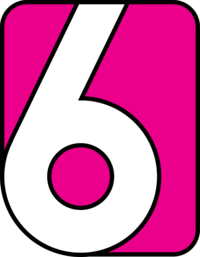| This article does not cite any sources. Please help improve this article by adding citations to reliable sources. Unsourced material may be challenged and removed. Find sources: "Canal 6" Salvadoran TV channel – news · newspapers · books · scholar · JSTOR (May 2023) (Learn how and when to remove this message) |
 | |
| Country | El Salvador |
|---|---|
| Headquarters | Alameda Dr. Manuel Araujo Km. 6½ San Salvador |
| Programming | |
| Language(s) | Spanish |
| Picture format | 1080i HDTV (downscaled to 480i for the SDTV feed) |
| Ownership | |
| Owner | Telecorporación Salvadoreña |
| Sister channels | Canal 2 Canal 4 TCS+ |
| History | |
| Launched | 26 April 1956; 68 years ago (1956-04-26) |
| Former names | YSEB-TV 6 (1956–1966) |
| Links | |
| Website | TCSGO.com |
| Availability | |
| Terrestrial | |
| Analog VHF (El Salvador) | Channel 6 |
| Streaming media | |
| TCS GO | TCS GO |
Canal Seis is the flagship television channel of Telecorporacion Salvadoreña. It broadcasts from channel 6 nationwide in El Salvador.
It is believed to be the country's first television station, having launched in 1956. Color broadcasts commenced in 1973.
The channel has a general schedule on weekdays and is focused on movies on weekends.
History
Early years
The first attempts to create television were made by Mexican inventor Rubén González on his own initiative on 7 September 1956, in black and white broadcast. In that same month Boris Eserski, Guillermo Pinto and Tono Alfaro, former owners of the radio station YSEB, collaborated in this creation. The first television channel launched was YSEB-TV. Its programming was based on national artistic presentations and films imported from Mexico and the United States Its programming was very short, it began at 4 in the afternoon and ended at 10 in the evening.
Days later, two other programs that Channel 6 had were included, one was a project of the Salvadoran writer Eugenio Martínez Orantes, who recited his poems live while a classical dance group interpreted them musically. The Teleperiódico program was hosted by Álvaro Menéndez Leal, a Salvadoran writer. A month later, Channel 6 implemented some new programming with Saturday Concerts, hosted by musician Nicolás Arene and Televariedades Pilsener.
In 1959, it took Channel 8 as a repeater, to cover a larger area nationwide. A year later, the television stations suffered a stagnation and a union was created between channels 4 and 6, which lasted until 1966, when Channel 6 interrupted its transmissions for the first time. In times, Channel 2 had been preferred by some audience. In July 1966, an agreement is signed to operate Canal 4.
On 6 April 1973, Canal Seis SA relaunched the company through YSLA-TV, which was the first to introduce color television. In 1986, together with Canal 2 and 4, Canal 6 was merged to form Telecorporación Salvadoreña.
Gallery
-
 Logo used from 1973 to 1977
Logo used from 1973 to 1977
-
 Logo used from 1986 to 1991
Logo used from 1986 to 1991
-
 Logo used from 1991 to 2005
Logo used from 1991 to 2005
-
 Logo used from 1991 to 1996 (with the words "TV Seis")
Logo used from 1991 to 1996 (with the words "TV Seis")
-
 Logo used from 1996 to 2002 (with its name in the corner)
Logo used from 1996 to 2002 (with its name in the corner)
-
 Logo used from 2006 to 2008
Logo used from 2006 to 2008
- [REDACTED] Current logo since 2008
- [REDACTED] Current logo (with slogan)
Notes
- Hiatus: 1966–1973
References
| Broadcast television stations in San Salvador, El Salvador | |
|---|---|
| TCS | |
| RSM (Albavision) |
|
| Grupo Megavisión |
|
| Public educational channels |
|
| independent/religious channels | |
| See also: Telecommunications in El Salvador | |
This article about a television station is a stub. You can help Misplaced Pages by expanding it. |
This El Salvador–related article is a stub. You can help Misplaced Pages by expanding it. |